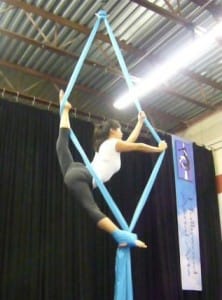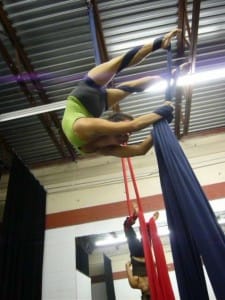During the holidays, cold weather and decadent food can make it challenging to stay active throughout the seemingly never-ending winter season. This year, ditch that boring gym workout for something a little different.

Christina Kaoh
You might have seen it at Cirque du Soleil or during Pink’s high flying performance at last year’s Grammy awards, and it’s called aerial silks. The performances are literally dances in the air complete with extreme poses and jaw-dropping drops. However, silks are much more than an acrobatic show—they provide a unique and challenging workout that requires a combination of flexibility and strength. I spoke with aerial silks enthusiast and class instructor Christina Kaoh about her passion for the big top.
In a nutshell, what do aerials and acrobatics technically consist of? Is there a proper name for it?
The sport (or performance art, really) that I practice the most, is known by several names: aerial silks, aerial acrobatics, and tissu (which is French for “fabric”). There are other apparatuses, such as aerial hoop, or lyra, which is a circular structure suspended on a rotating point; aerial straps, which consist of straps which the performer grabs by the hand or loops their foot into; and rope, or corde lisse, which is a fabric covered rope. Static and flying trapeze are other forms of aerial arts.
How popular do you think that aerial silks currently are?
It’s become increasingly used as an exercise and more and more appreciated as a performance art. People, such as myself, train in aerial arts for the pure performance aspect of it and gain the strength and flexibility in the mean time. But a lot of classes use aerial apparatus these days as fitness apparatus and build conditioning classes based on aerial moves. It’s also become increasingly blended with yoga to ease practitioners into upside down poses and help increase flexibility.
How did you first get started?

Which muscles do aerial silks work? What health benefits does it have?
Aerial arts definitely work your back, core and shoulders, to name a few. Even your legs are engaged to keep them straight, lift them up and over your head, or keep your toes pointed. It really is a total body workout that engages parts of your body that may not be engaged in more traditional forms of exercise. Learning aerial arts can make you more flexible and it is an anaerobic workout since it forces you to work against gravity and use your own body weight by pulling yourself up or over the fabric. I also think it has psychological benefits because it forces you to face your fear of heights, being upside down and being in unconventional positions.
How can I get started with aerials and acrobatics?
Just go for it! That’s what I did anyway. I always hear, “I don’t have any upper body strength, so I’m going to wait till I’ve worked out more.” No. You’ll build it as you go. I could never complete a pull-up before and now I can do six really good ones at a time and it all came from going to class. Each time you struggle to pull yourself up the fabric or into a pose, you are strengthening your muscles. Be prepared to work muscles you may not normally use, such as back muscles, your forearms, and your hands. Your hand grip will become much stronger in time.
What can I search for when looking for gyms?

Editor’s Note: Christina Kaoh is an aerial silks instructor at Urban Evolution gym in Alexandria, Va. She has been practicing silks on and off for the last four years.
No Comments